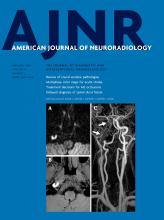Index by author
Smith, G.
- Pediatric NeuroimagingYou have accessFrequency, Extent, and Correlates of Superficial Siderosis and Ependymal Siderosis in Premature Infants with Germinal Matrix Hemorrhage: An SWI StudyM.S. Albayram, G. Smith, F. Tufan and M.D. WeissAmerican Journal of Neuroradiology February 2020, 41 (2) 331-337; DOI: https://doi.org/10.3174/ajnr.A6371
Snyder, K.V.
- EDITOR'S CHOICEAdult BrainYou have accessAssessment of a Bayesian Vitrea CT Perfusion Analysis to Predict Final Infarct and Penumbra Volumes in Patients with Acute Ischemic Stroke: A Comparison with RAPIDR.A. Rava, K.V. Snyder, M. Mokin, M. Waqas, A.B. Allman, J.L. Senko, A.R. Podgorsak, M.M. Shiraz Bhurwani, Y. Hoi, A.H. Siddiqui, J.M. Davies, E.I. Levy and C.N. IonitaAmerican Journal of Neuroradiology February 2020, 41 (2) 206-212; DOI: https://doi.org/10.3174/ajnr.A6395
Data were retrospectively collected for 105 patients with acute ischemic stroke (55 patients with successful recanalization [TICI 2b/2c/3] and large-vessel occlusions and 50 patients without interventions). Final infarct volumes were calculated using DWI and FLAIR 24 hours following CTP imaging. RAPID and the Vitrea Bayesian CTP algorithm (with 3 different settings) predicted infarct and penumbra volumes for comparison with final infarct volumes to assess software performance. RAPID and Vitrea default setting had the most accurate final infarct volume prediction in patients with interventions. Default Vitrea and RAPID were the most and least accurate in determining final infarct volume for patients without an intervention, respectively. Compared with RAPID, the Vitrea default setting was noninferior for patients with interventions and superior in penumbra estimation for patients without interventions as indicated by mean infarct differences and correlations with final infarct volumes.
Song, P.
- Adult BrainOpen AccessMR Diffusional Kurtosis Imaging–Based Assessment of Brain Microstructural Changes in Patients with Moyamoya Disease before and after RevascularizationP.-G. Qiao, X. Cheng, G.-J. Li, P. Song, C. Han and Z.-H. YangAmerican Journal of Neuroradiology February 2020, 41 (2) 246-254; DOI: https://doi.org/10.3174/ajnr.A6392
Strauss, S.B.
- Spine Imaging and Spine Image-Guided InterventionsYou have accessDifferentiation between Tuberculous and Pyogenic Spondylodiscitis: The Role of the Anterior Meningovertebral Ligament in Patients with Anterior Epidural AbscessS.B. Strauss, S.R. Gordon, J. Burns, J.A. Bello and S.E. SlaskyAmerican Journal of Neuroradiology February 2020, 41 (2) 364-368; DOI: https://doi.org/10.3174/ajnr.A6370
Sugrue, L.P.
- Adult BrainYou have accessPredictive Value of Noncontrast Head CT with Negative Findings in the Emergency Department SettingA.L. Callen, D.S. Chow, Y.A. Chen, H.R. Richelle, J. Pao, M. Bardis, B.D. Weinberg, C.P. Hess and L.P. SugrueAmerican Journal of Neuroradiology February 2020, 41 (2) 213-218; DOI: https://doi.org/10.3174/ajnr.A6408
Suzuki, S.
- Adult BrainYou have accessVisualization of Lenticulostriate Arteries on CT Angiography Using Ultra-High-Resolution CT Compared with Conventional-Detector CTK. Murayama, S. Suzuki, H. Nagata, J. Oda, I. Nakahara, K. Katada, K. Fujii and H. ToyamaAmerican Journal of Neuroradiology February 2020, 41 (2) 219-223; DOI: https://doi.org/10.3174/ajnr.A6377
Takeshima, H.
- Extracranial VascularOpen AccessCharacterization of Carotid Plaque Components by Quantitative Susceptibility MappingM. Azuma, K. Maekawa, A. Yamashita, K. Yokogami, M. Enzaki, Z.A. Khant, H. Takeshima, Y. Asada, Y. Wang and T. HiraiAmerican Journal of Neuroradiology February 2020, 41 (2) 310-317; DOI: https://doi.org/10.3174/ajnr.A6374
Tanoue, S.
- Adult BrainYou have accessMetal Artifact Reduction in Head CT Performed for Patients with Deep Brain Stimulation Devices: Effectiveness of a Single-Energy Metal Artifact Reduction AlgorithmY. Nagayama, S. Tanoue, S. Oda, D. Sakabe, T. Emoto, M. Kidoh, H. Uetani, A. Sasao, T. Nakaura, O. Ikeda, K. Yamada and Y. YamashitaAmerican Journal of Neuroradiology February 2020, 41 (2) 231-237; DOI: https://doi.org/10.3174/ajnr.A6375
Temkit, M.
- EDITOR'S CHOICEAdult BrainYou have accessSpiral T1 Spin-Echo for Routine Postcontrast Brain MRI Exams: A Multicenter Multireader Clinical EvaluationM.B. Ooi, Z. Li, R.K. Robison, D. Wang, A.G. Anderson, N.R. Zwart, A. Bakhru, S. Nagaraj, T. Mathews, S. Hey, J.J. Koonen, I.E. Dimitrov, H.T. Friel, Q. Lu, M. Obara, I. Saha, H. Wang, Y. Wang, Y. Zhao, M. Temkit, H.H. Hu, T.L. Chenevert, O. Togao, J.A. Tkach, U.D. Nagaraj, M.C. Pinho, R.K. Gupta, J.E. Small, M.M. Kunst, J.P. Karis, J.B. Andre, J.H. Miller, N.K. Pinter and J.G. PipeAmerican Journal of Neuroradiology February 2020, 41 (2) 238-245; DOI: https://doi.org/10.3174/ajnr.A6409
The authors report a multicenter multireader study that was designed to compare spiral with standard-of-care Cartesian postcontrast structural brain MR imaging on the basis of relative performance in 10 metrics of image quality, artifact prevalence, and diagnostic benefit. Seven clinical sites acquired 88 total subjects. For each subject, sites acquired 2 postcontrast MR imaging scans: a spiral 2D T1 spin-echo, and 1 of 4 routine Cartesian 2D T1 spin-echo/TSE scans. Nine neuroradiologists independently reviewed each subject, with the matching pair of spiral and Cartesian scans compared side-by-side, and scored the subject on 10 image-quality metrics. Spiral was superior to Cartesian in 7 of 10 metrics (flow artifact mitigation, SNR, GM/WM contrast, image sharpness, lesion conspicuity, preference for diagnosing abnormal enhancement, and overall intracranial image quality), comparable in 1 of 10 metrics (motion artifacts), and inferior in 2 of 10 metrics (susceptibility artifacts, overall extracranial image quality). Spiral 2D T1 spin-echo for routine structural brain MR imaging is feasible in the clinic with conventional scanners and was preferred by neuroradiologists for overall postcontrast intracranial evaluation.
Tinkle, C.L.
- Pediatric NeuroimagingYou have accessMRI Patterns of Extrapontine Lesion Extension in Diffuse Intrinsic Pontine GliomasL. Makepeace, M. Scoggins, B. Mitrea, Y. Li, A. Edwards, C.L. Tinkle, S. Hwang, A. Gajjar and Z. PatayAmerican Journal of Neuroradiology February 2020, 41 (2) 323-330; DOI: https://doi.org/10.3174/ajnr.A6391








